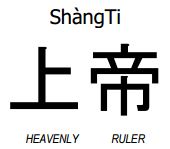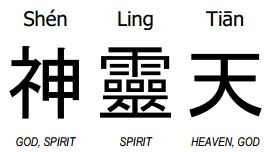Author : William Stewart, via lookinguntojesus.net
…Thou, O Spiritual Sovereign…
An investigation of the religious history of China is unlikely to leave one with the impression that the Chinese were once a monotheistic culture, worshiping the one true God of heaven. The traditional religions of China are Taoism, Confucianism, and Buddhism. These, along with Islam and Christianity, exist in China today, though the vast majority of people in the People’s Republic of China are nonreligious (ie. atheistic).1
However, if we look beyond the traditional religions of China, there is a forgotten past which has been preserved in the written language of the Chinese people. There, we find a time when a single deity was acknowledged, known as ShàngTi (上帝).
 In the Shu Ching (book of history), Confucius recorded that Emperor Shun (2,230 B.C.) “…sacrificed to ShàngTi.”2 In fact, in the midst of the ceremony before ShàngTi (上帝), the emperor would recite the following:
In the Shu Ching (book of history), Confucius recorded that Emperor Shun (2,230 B.C.) “…sacrificed to ShàngTi.”2 In fact, in the midst of the ceremony before ShàngTi (上帝), the emperor would recite the following:
Of old in the beginning, there was the great chaos, without form and dark … Thou, O spiritual Sovereign camest forth in Thy presidency… Thou madest heaven; thou madest earth; thou madest man…
Those who are familiar with the Bible may immediately notice a similarity to the following, recorded in the Hebrew Scriptures:
In the beginning, God created the heaven and the earth. And the earth was without form, and void; and darkness was upon the face of the deep. … And God said, ‘Let us make man in our image, after our likeness…’ (Genesis 1:1-2, 26, NKJV)
The ancient Chinese emperor sacrificed to and glorified ShàngTi (上帝), the heavenly ruler (also rendered ShàngDi). It is intriguing to notice the phonetic similarity of ShàngDi (上帝) to the Hebrew Shaddai (Almighty). Did the ancient Chinese worship the same God that the Hebrews did?
 Consider three other Chinese characters used to represent God. The word Shén (神) may also be written as 示申. The etymology of this image reveals details about God’s work in creation. Ling (靈), combined with the word HOLY (shèng, 聖) refers to the person of God in the New Testament known as the Holy Spirit. But even more significant, the etymology of Ling (靈) reveals that the ancient Chinese had the knowledge of the three persons of the Godhead.
Consider three other Chinese characters used to represent God. The word Shén (神) may also be written as 示申. The etymology of this image reveals details about God’s work in creation. Ling (靈), combined with the word HOLY (shèng, 聖) refers to the person of God in the New Testament known as the Holy Spirit. But even more significant, the etymology of Ling (靈) reveals that the ancient Chinese had the knowledge of the three persons of the Godhead.
Tiān (天) can refer to the sky or heavens, and could be broken down to refer to TWO (èr, 二) PEOPLE (rén, 人). However, we might question whether this conveys the best origin for the word. What do two people have to do with the sky or heaven? A more plausible analysis reveals this word to be speaking about the One who is beyond the sky or in heaven. Found in the character Tiān (天) are the words GREAT (dà, 大) and ONE (yī, 一). Indeed, ShàngDi (上帝) is the GREAT ONE!
Ling (靈) has several smaller characters in it. In the upper half of this ancient syntax, there is pictured ONE (yī, 一) who COVERS (mì, 冖) the WATERS (shuĭ, 氺). The creation account in the Hebrew Scriptures reveals that
… the Spirit of God was hovering over the face of the waters. (Genesis 1:2, NKJV)
 In the lower portion of Ling (靈), there appears to be a reference to the three persons of the Godhead with three MOUTHS (kŏu, 口) pictured together (*). Below these three persons we see the character for a WORKER OF MAGIC (wū, 巫), bringing to mind the miraculous power of God at work in creation. In this character, the three persons of God are pictured yet again. We find two PERSONS (rén, 人) and the image for WORK (gōng, 工). Where is the third person? The centerpiece of work (gŭn, 丨) may also represent a person. A horizontal line (yī, 一) may mean ONE as indicated above, but can also represent ENTIRE, WHOLE or ALL. The two horizontal lines in this image may emphatically refer to the heavens and earth, all that which resulted from God’s miraculous creative power.
In the lower portion of Ling (靈), there appears to be a reference to the three persons of the Godhead with three MOUTHS (kŏu, 口) pictured together (*). Below these three persons we see the character for a WORKER OF MAGIC (wū, 巫), bringing to mind the miraculous power of God at work in creation. In this character, the three persons of God are pictured yet again. We find two PERSONS (rén, 人) and the image for WORK (gōng, 工). Where is the third person? The centerpiece of work (gŭn, 丨) may also represent a person. A horizontal line (yī, 一) may mean ONE as indicated above, but can also represent ENTIRE, WHOLE or ALL. The two horizontal lines in this image may emphatically refer to the heavens and earth, all that which resulted from God’s miraculous creative power.
Above it was stated that Shén (神) may also appear as 示申. This Chinese word for God tells us about creation. On the left, we see an image meaning to REVEAL or DECLARE (shì, 示). Over and over in the Biblical creation account, we are told that “…God said…” (Genesis 1:3, 6, 9, 11, 14, 20, 24, 26). The Psalmist declared of God’s work of creation:
By the word of the LORD the heavens were made, and all the host of them by the breath of His mouth. …For He spoke, and it was done; He commanded, and it stood fast. (Psalm 33:6,9, NKJV)
On the right side of the character, two images are intertwined. There, we find a MAN (gŭn, 丨) and a GARDEN (tián, 田). Man, the crowning jewel of God’s creation (Genesis 1:26), was placed in the garden of Eden. Moses recorded,
The LORD God planted a garden eastward in Eden, and there He put the man whom He had formed. (Genesis 2:8, NKJV)
These four characters, ShàngTi (上帝), Shén (神), Ling (靈), and Tiān (天), all refer to God Almighty, and agree with the testimony of the Hebrew Scriptures. In them, we see the greatness of God conveyed, and His power and involvement in the creation of all things that exist. Some might consider the agreement between the Chinese characters and the Hebrew Scriptures to be coincidental. That would be quite a coincidence! Friend, much more evidence is yet to come.
1, National Geographic, May 2008 (as per chinatoday.com/people/people.htm)
2, The Discovery of Genesis, p. 14., Ethel R. Nelson & C.H. Kang
Other Resources:
Nelson, Ethel R. & C.H. Kang. The Discovery of Genesis: How the Truths of Genesis Were Found Hidden in the Chinese Language, St. Louis, MO : Concordia Publishing House, 1979.
Nelson, Ethel R., Richard E. Broadberry, & Ginger Tong Chock. God’s Promise to the Chinese, Dunlap, TN : Read Books Publishers, 1997.
MDBG Chinese-English Dictionary, mdbg.net/chindict/chindict.php

